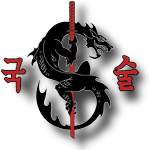TERMINOLOGY USED IN KUK-SOOL
Below
is some of the terminology used in Kuk Sool. Because the Korean alphabet
(Han Geul) uses a completely different writing system than
English, be advised that the spellings below in
blue are only phonetic approximations, so please
consult with a native Korean speaker for proper pronunciation.
Furthermore, be aware that this web page was designed to take advantage of the capabilities of NEWER browsers.
It uses Unicode symbols which can display virtually any written language on the planet.
In the event you see peculiar text, blank boxes or punctuation marks instead of Korean writing at the
beginning of each term, simply click on the button below to go to a different
version of this web page which uses GIFs instead of Unicode (and be patient
while all of the GIF images load into the page).
|
It is important to make the clarification that this page does not follow the latest prescription for standardized Romanization as laid out by the South Korean Government. Instead, phonetic approximations were used to best help non–Koreans with proper pronunciation without the need to consult a pronuciation guide. However, below you will find some links that will help inform you about the current standardized Romanization system, just in case you are interested. |
| The Romanization of Korean | ||||||||||||||||||||||||||||||||||||||||
| The Revised Romanization of Korean | ||||||||||||||||||||||||||||||||||||||||
| What is Hangeul? | ||||||||||||||||||||||||||||||||||||||||
If you are interested in investigating the nature of hangeul further, here are two other sources to explore, which include the history, construction, Romanization, and other interesting tidbits about the Korean language (sometimes including interactive tools). |
||||||||||||||||||||||||||||||||||||||||
| Link to Omniglot | ||||||||||||||||||||||||||||||||||||||||
|
Link to zKorean |
||||||||||||||||||||||||||||||||||||||||
|
Only 24 of the original 28 Hangeul glyphs are still used today, and serve as the basis for the many variations and combinations seen in the modern-day language of Korea: Consonants: Vowels:
Some basics of Hangeul Romanization can be found below. For further information & details, please follow the LINKS provided above. 1. Basic Principles of Romanization 2. A Brief Summary of the Romanization System (1) Vowels are transcribed as follows:
| ||||||||||||||||||||||||||||||||||||||||

 “№ 10” Block)
“№ 10” Block)







